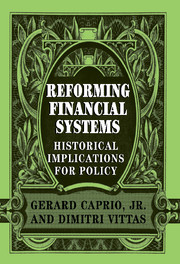Book contents
- Frontmatter
- Contents
- List of contributors
- Foreword
- 1 Financial history: Lessons of the past for reformers of the present
- 2 The evolution of central banking
- 3 Free banking: The Scottish experience as a model for emerging economies
- 4 Regulation and bank stability: Canada and the United States, 1870–1980
- 5 Deposit insurance
- 6 Contingent liability in banking: Useful policy for developing countries?
- 7 Universal banking and the financing of industrial development
- 8 Before main banks: A selective historical overview of Japan's prewar financial system
- 9 Thrift deposit institutions in Europe and the United States
- 10 The development of industrial pensions in the United States during the twentieth century
- 11 The rise of securities markets: What can government do?
- Index
6 - Contingent liability in banking: Useful policy for developing countries?
Published online by Cambridge University Press: 25 March 2010
- Frontmatter
- Contents
- List of contributors
- Foreword
- 1 Financial history: Lessons of the past for reformers of the present
- 2 The evolution of central banking
- 3 Free banking: The Scottish experience as a model for emerging economies
- 4 Regulation and bank stability: Canada and the United States, 1870–1980
- 5 Deposit insurance
- 6 Contingent liability in banking: Useful policy for developing countries?
- 7 Universal banking and the financing of industrial development
- 8 Before main banks: A selective historical overview of Japan's prewar financial system
- 9 Thrift deposit institutions in Europe and the United States
- 10 The development of industrial pensions in the United States during the twentieth century
- 11 The rise of securities markets: What can government do?
- Index
Summary
Bank owner contingent liability has been an important component in the developmental history of many industrial countries. For example, Scotland imposed unlimited liability on bank owners until 1862, when banks were allowed to adopt a limited liability designation. As a result, Scotland was relatively free of the banking and monetary upheavals that occurred in Britain and the United States. In addition, the United States conducted a long regulatory experiment with double liability, which started with the “free banking” movement in the early 1900s and was phased out as part of the post-depression reforms of the 1930s.
Thus, some form of contingent liability has been seen in the development of many industrial countries, suggesting that contingent liability systems might play an important policy role for many developing countries. This chapter traces the history of contingent liability in banking, with particular emphasis on Scotland and the United States. We discuss the potential advantages of contingent liability in a developing country context, as well as theoretical weaknesses and possible solutions.
We also argue that double liability and deposit insurance are not incompatible regulatory policies, even though federal deposit insurance was legislated in 1933 to replace double liability. In fact, they coexisted prior to 1933 – national bank notes carried a federal guarantee against loss at redemption. Further, in 1991 the Federal Deposit Insurance Corporation Improvement Act (FDICIA) legislated an early closure rule that was meant to impose greater regulatory discipline by enforcing post closure losses on bank stockholders, much as with double liability.
- Type
- Chapter
- Information
- Reforming Financial SystemsHistorical Implications for Policy, pp. 101 - 112Publisher: Cambridge University PressPrint publication year: 1997



